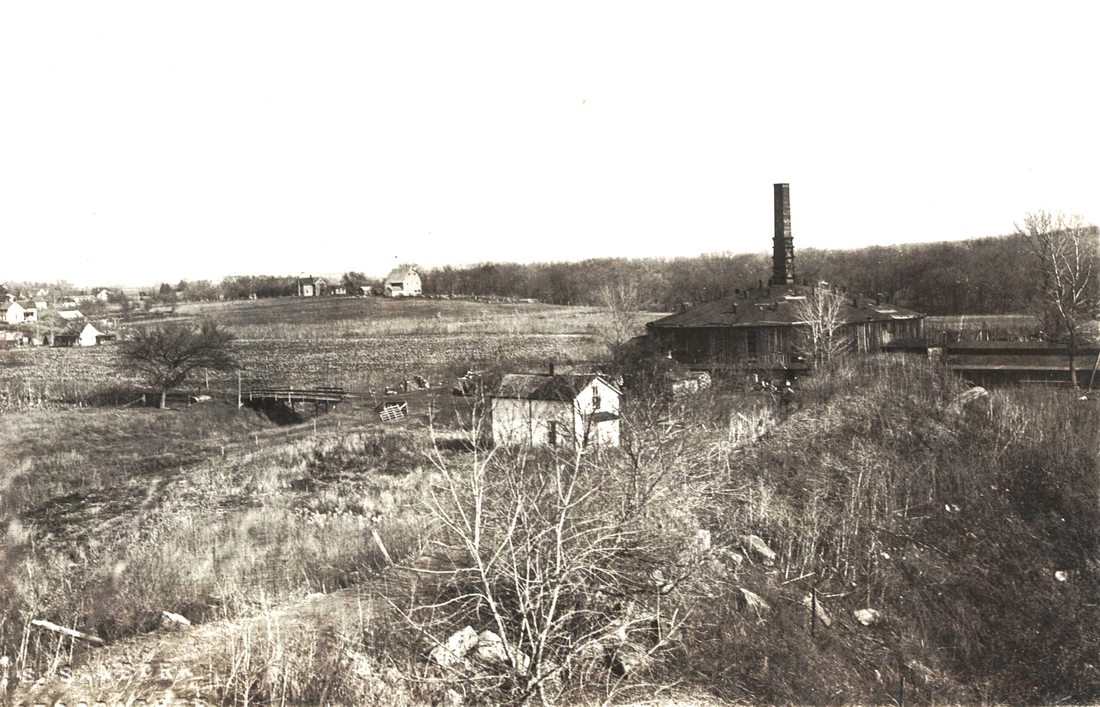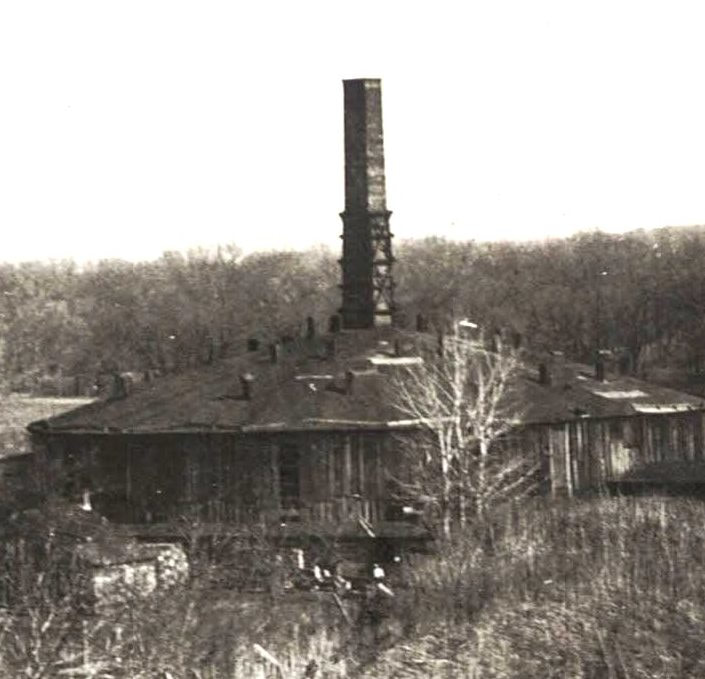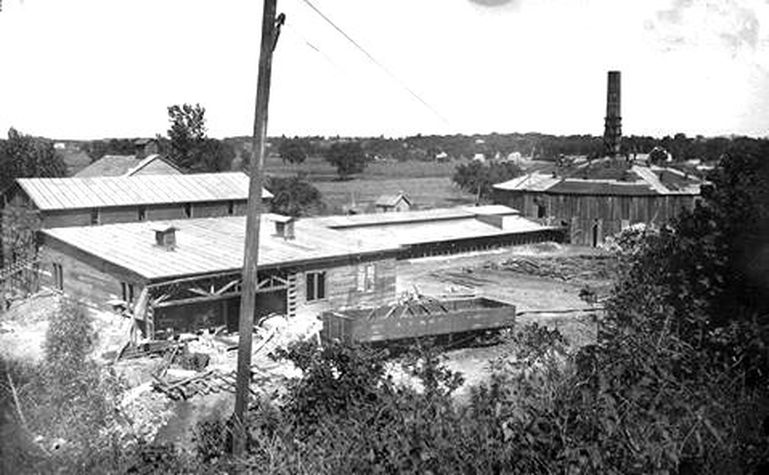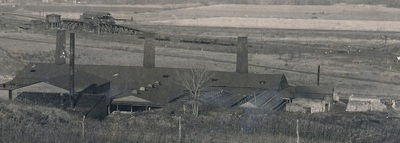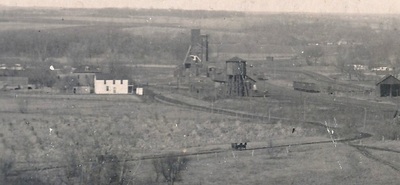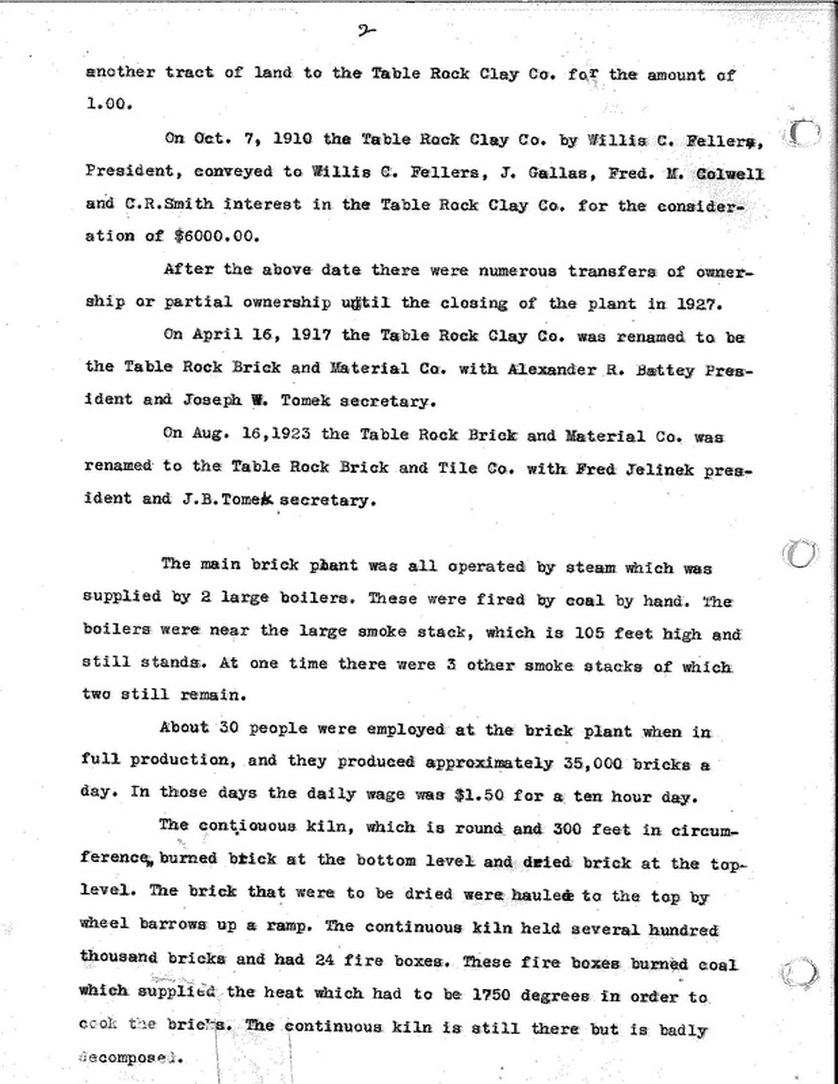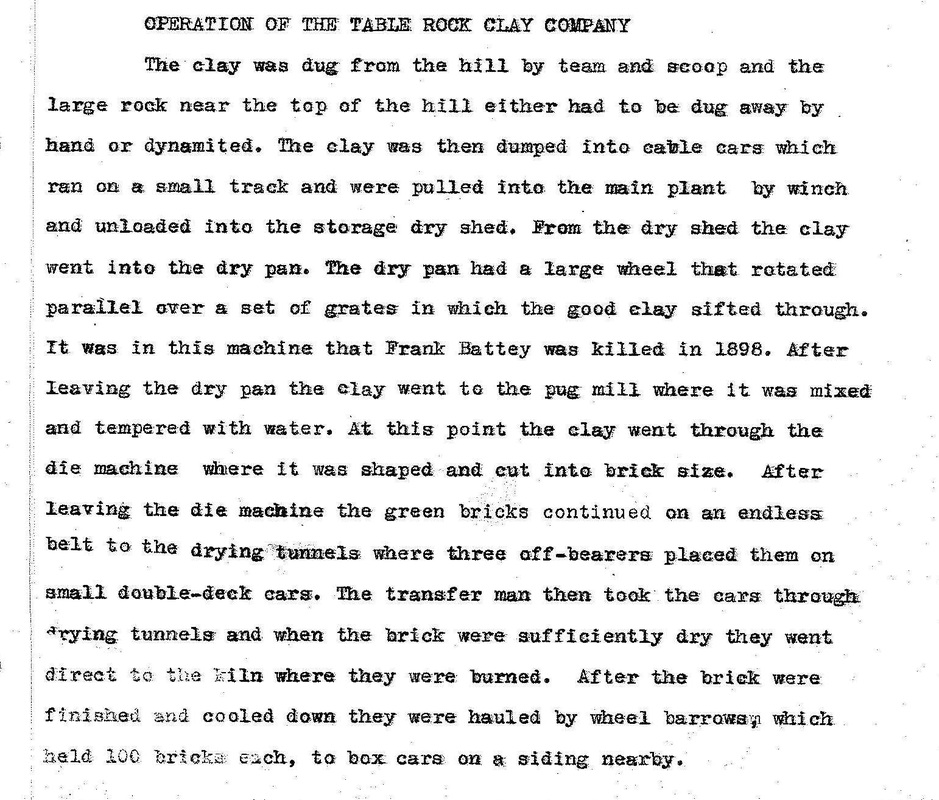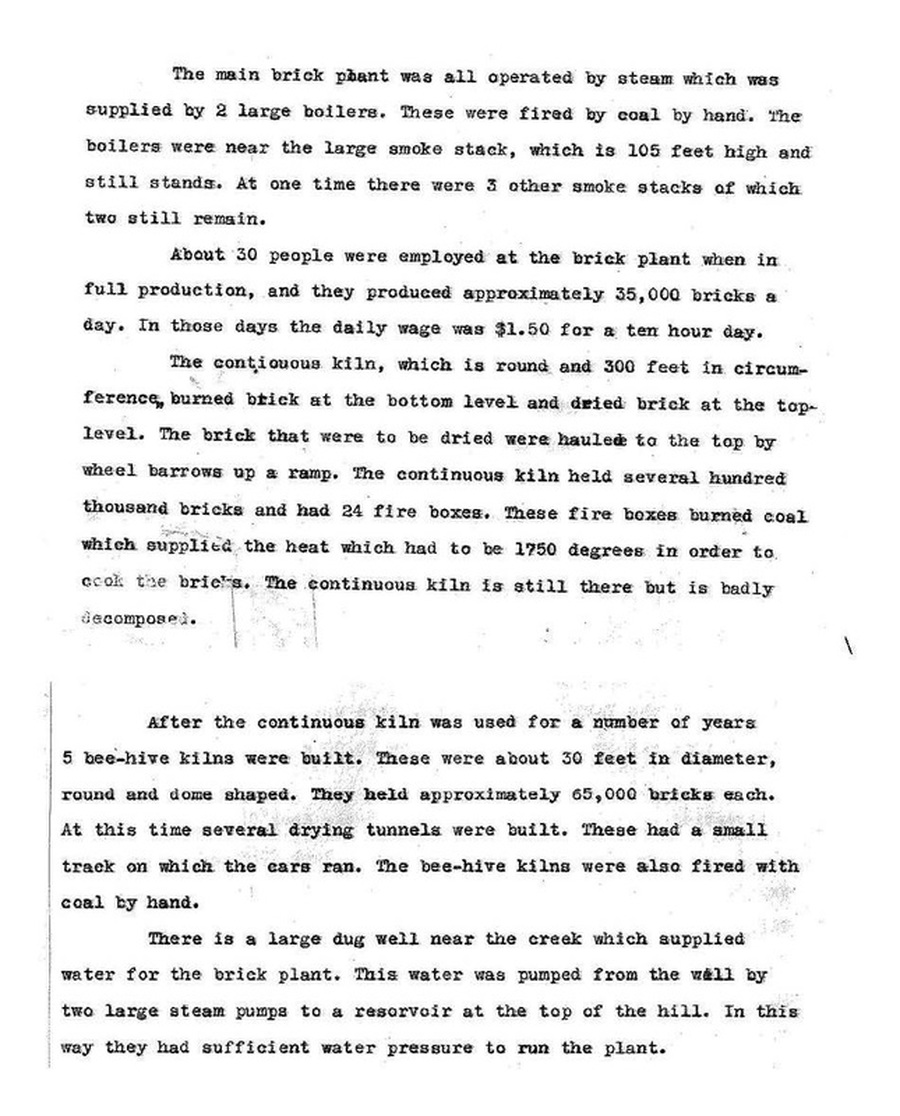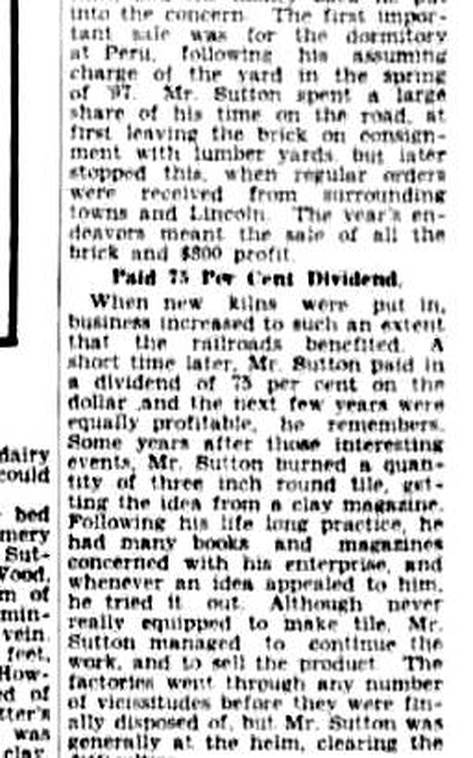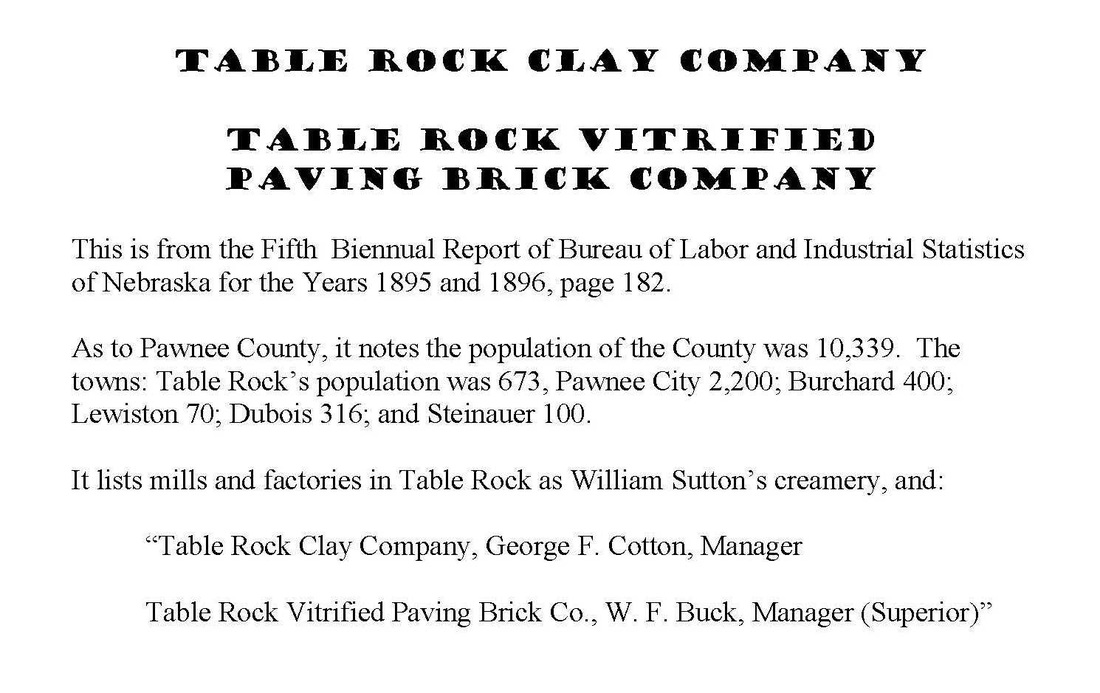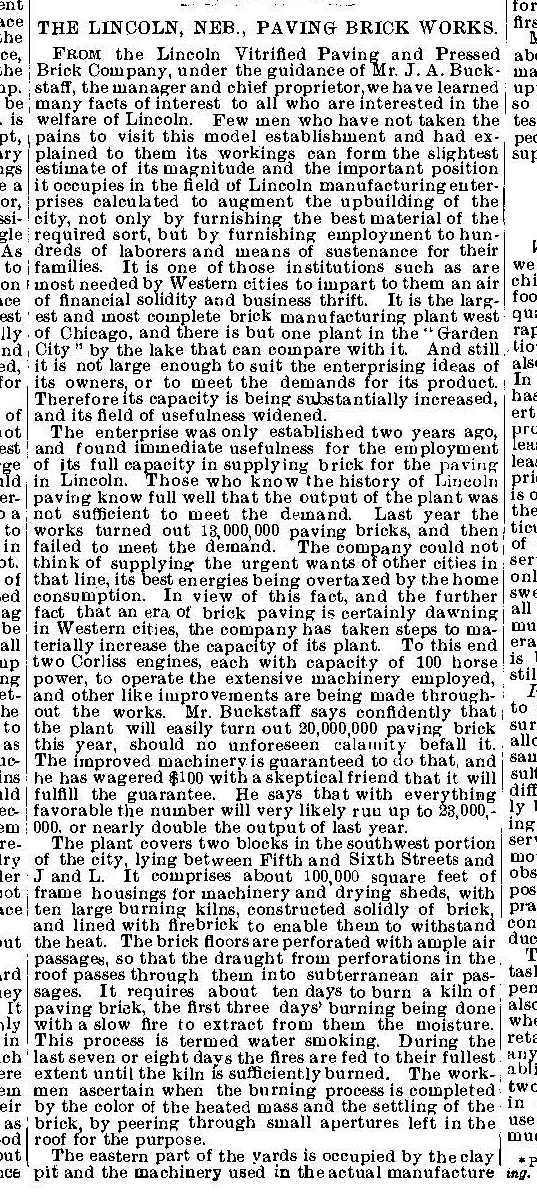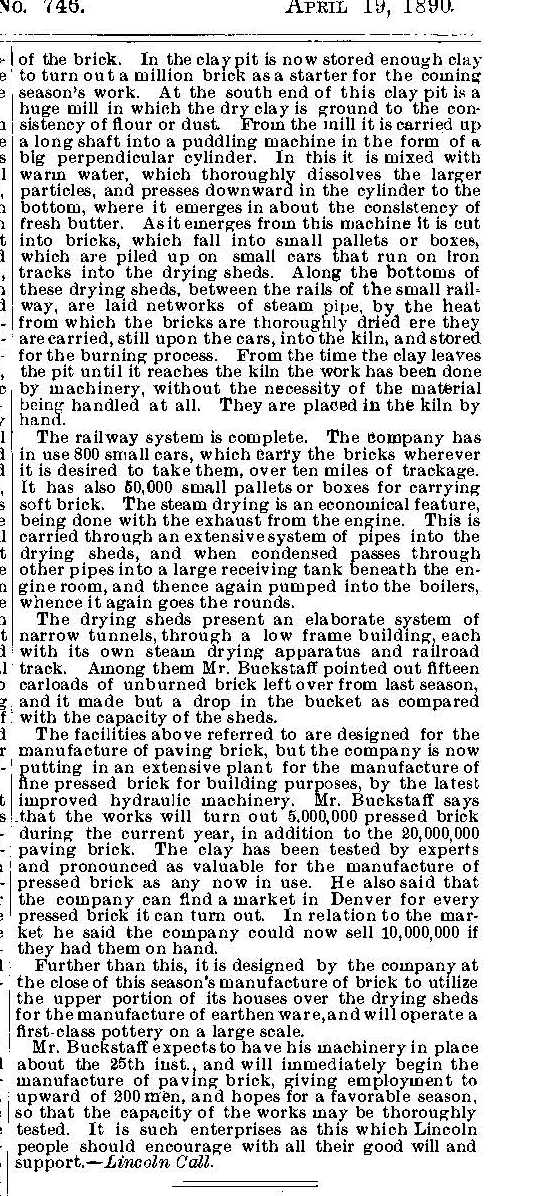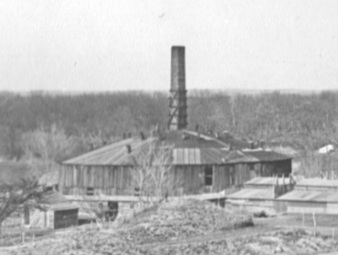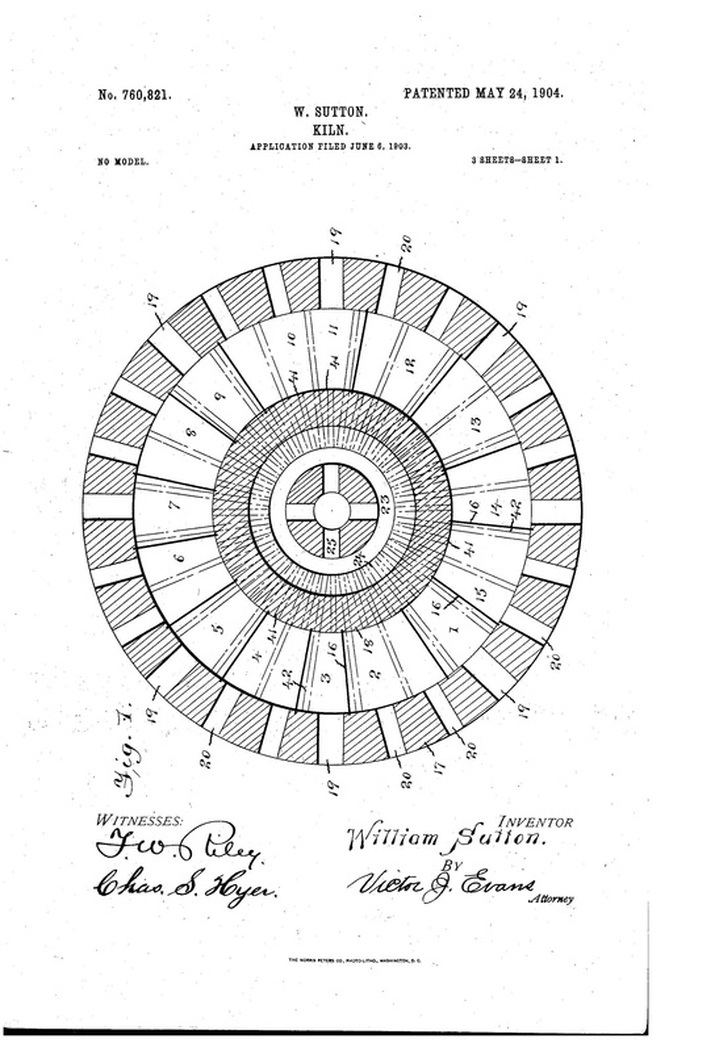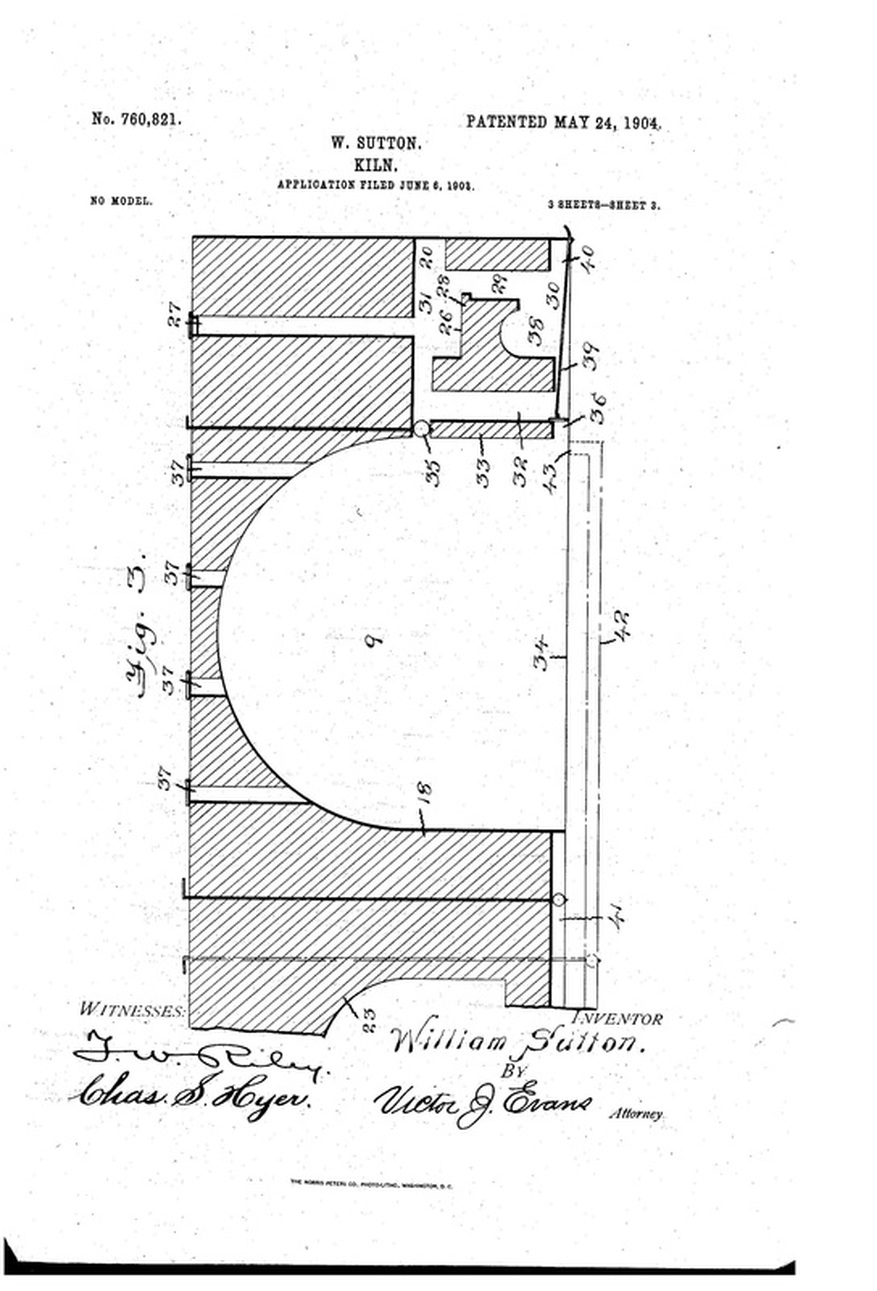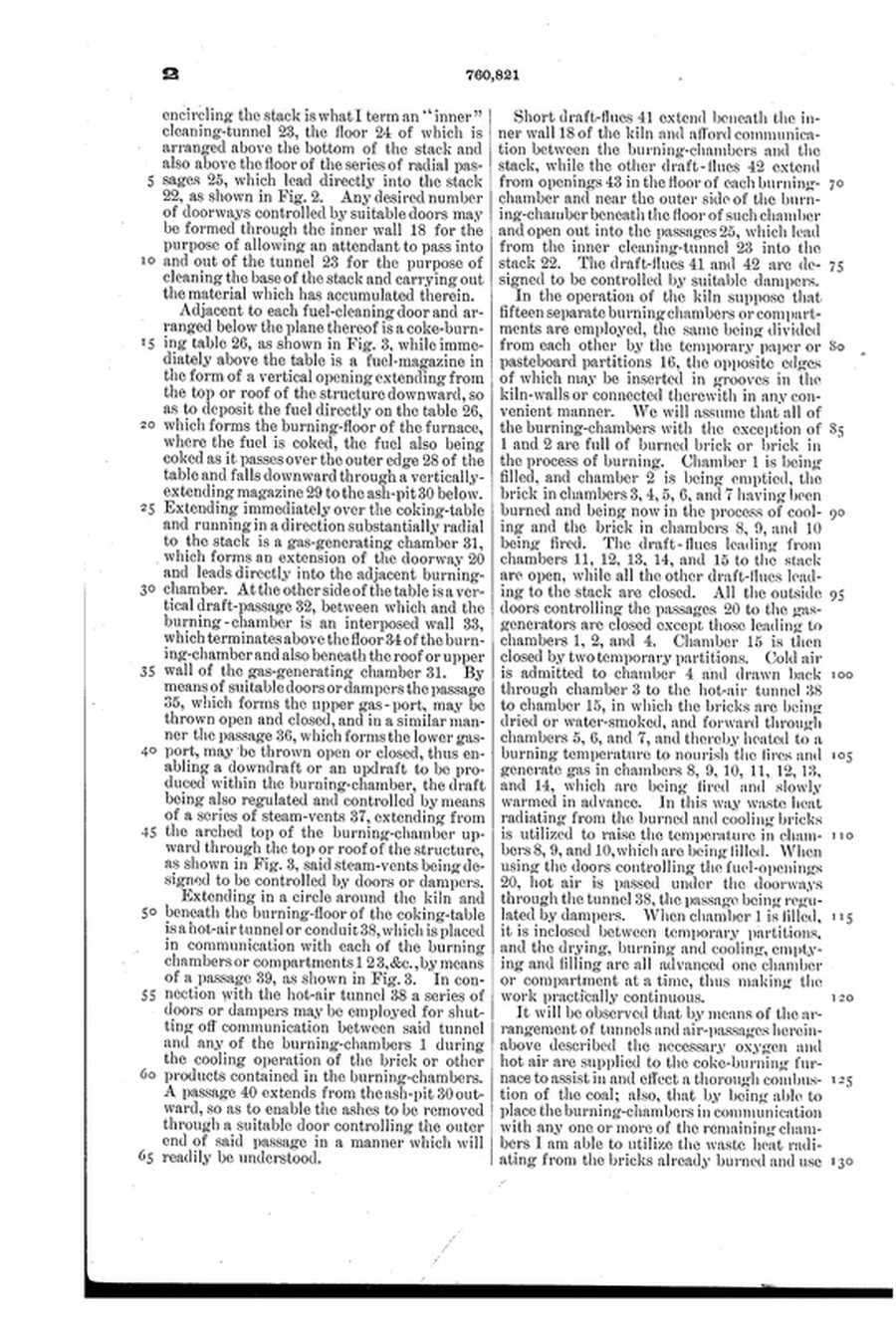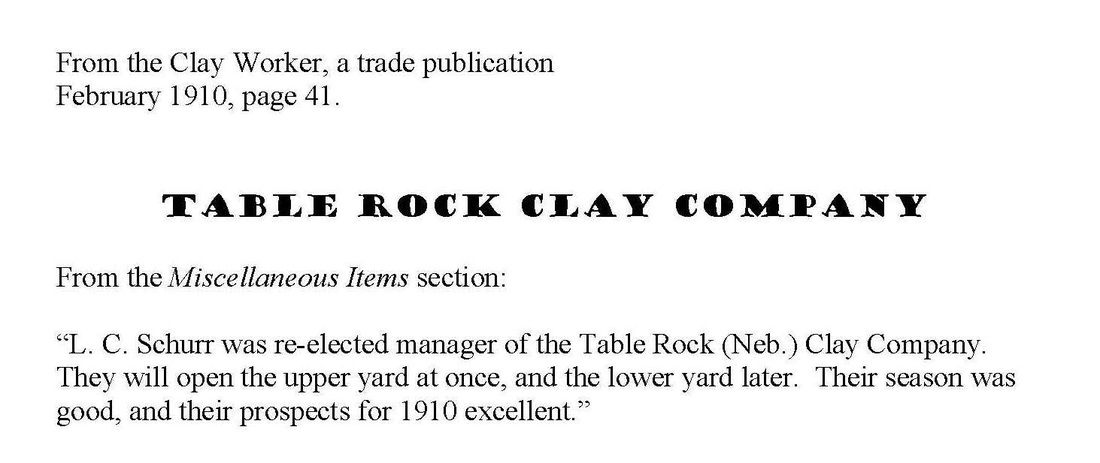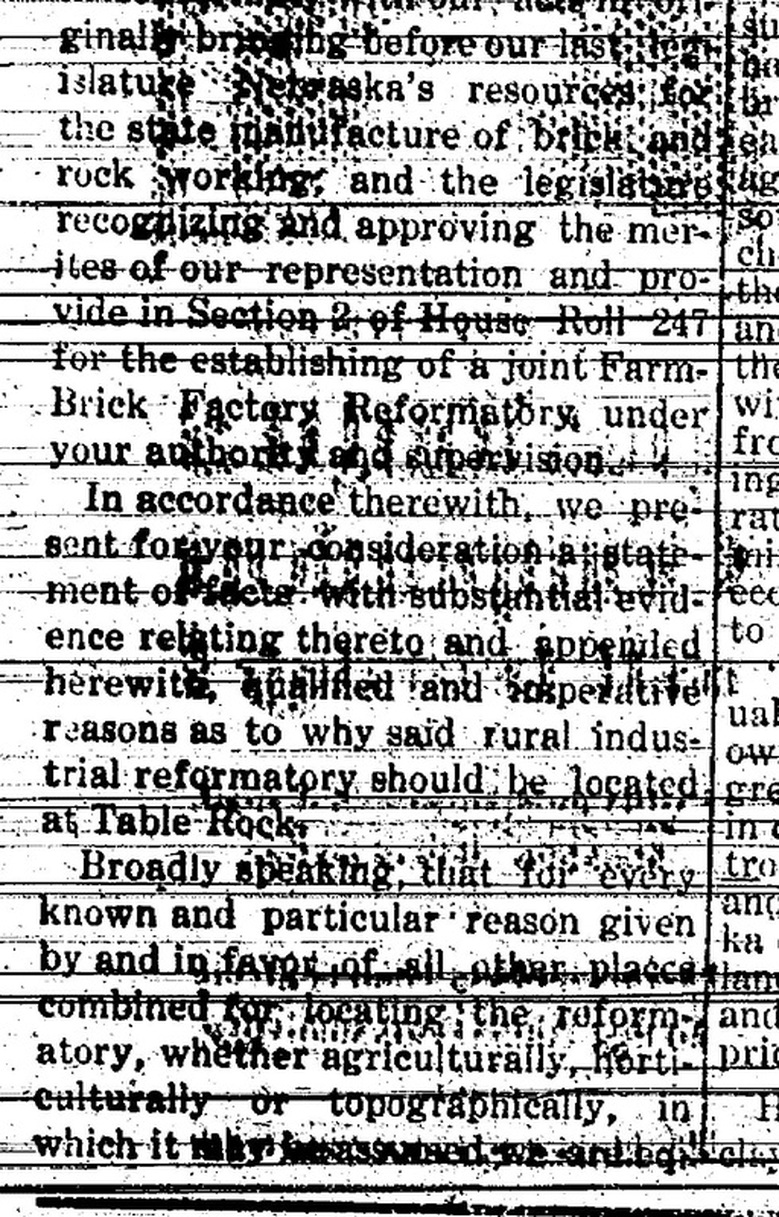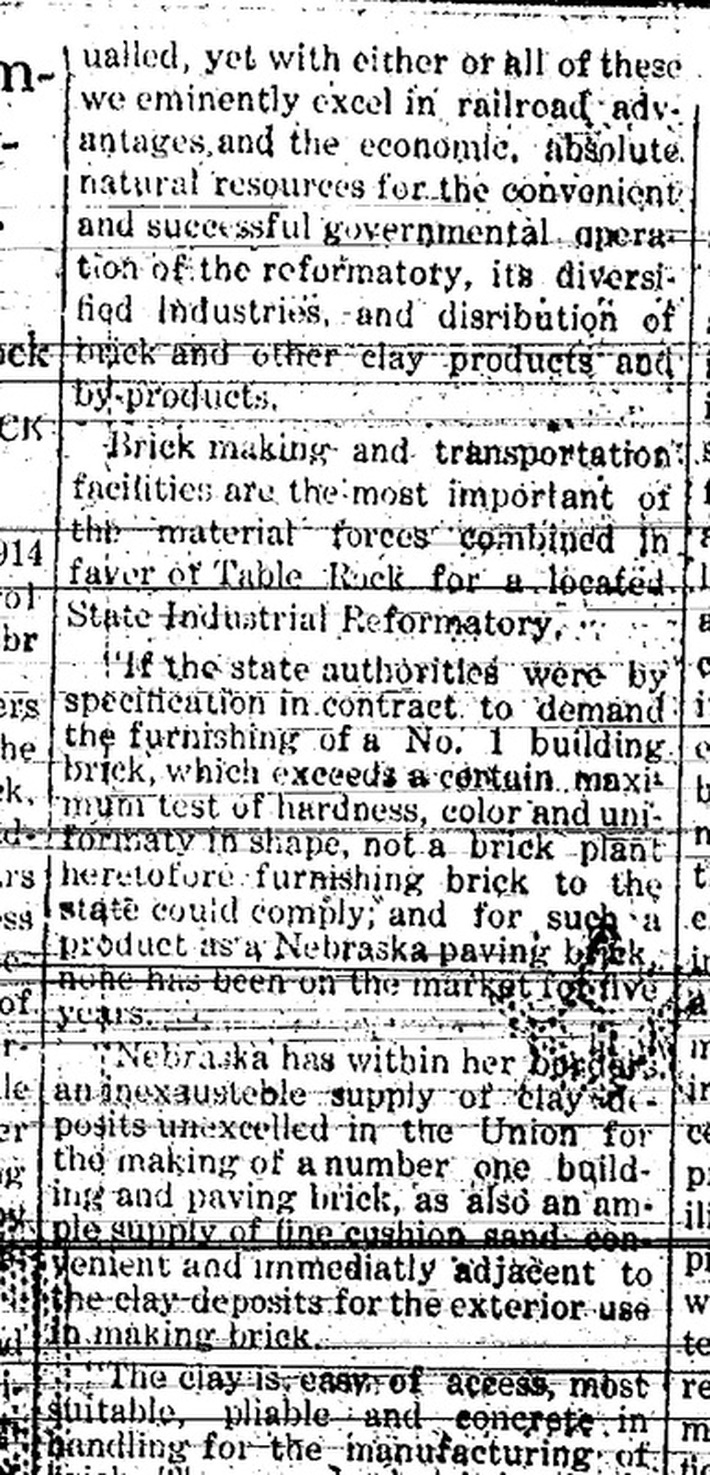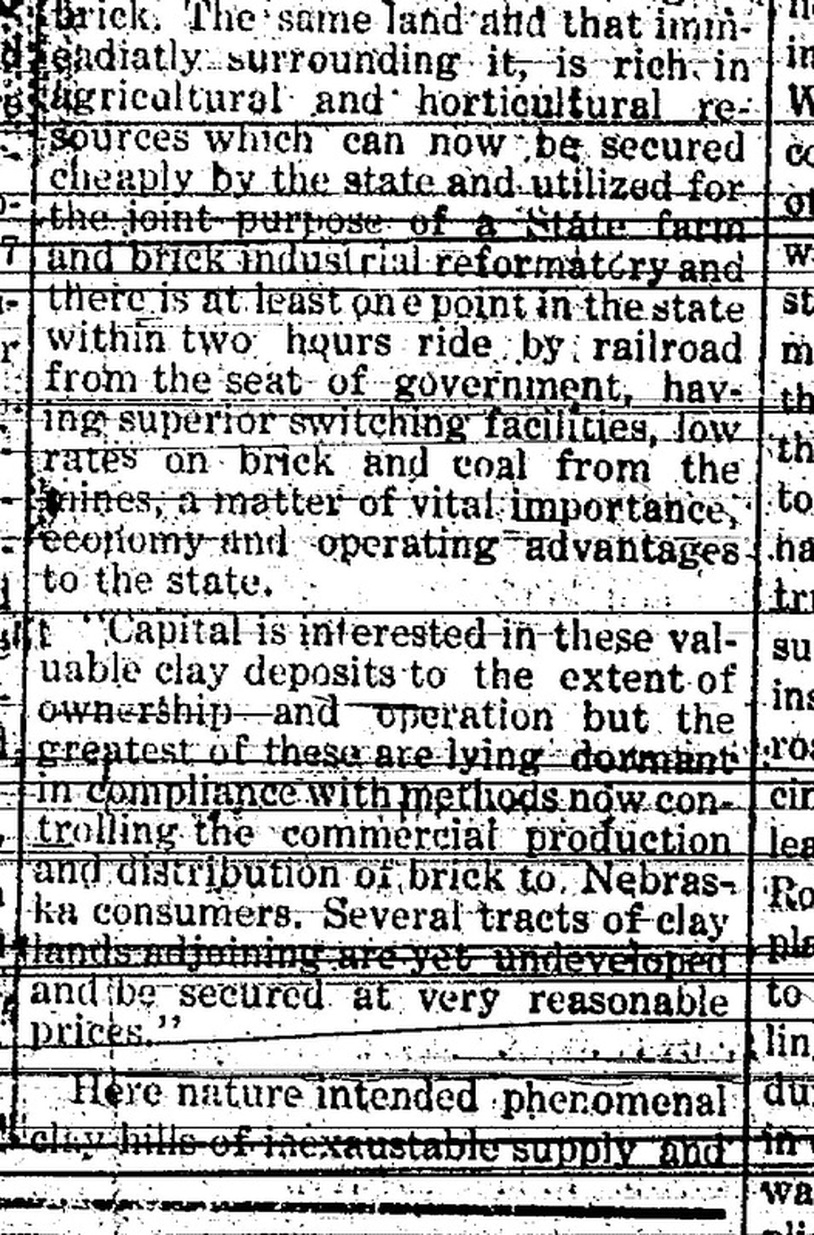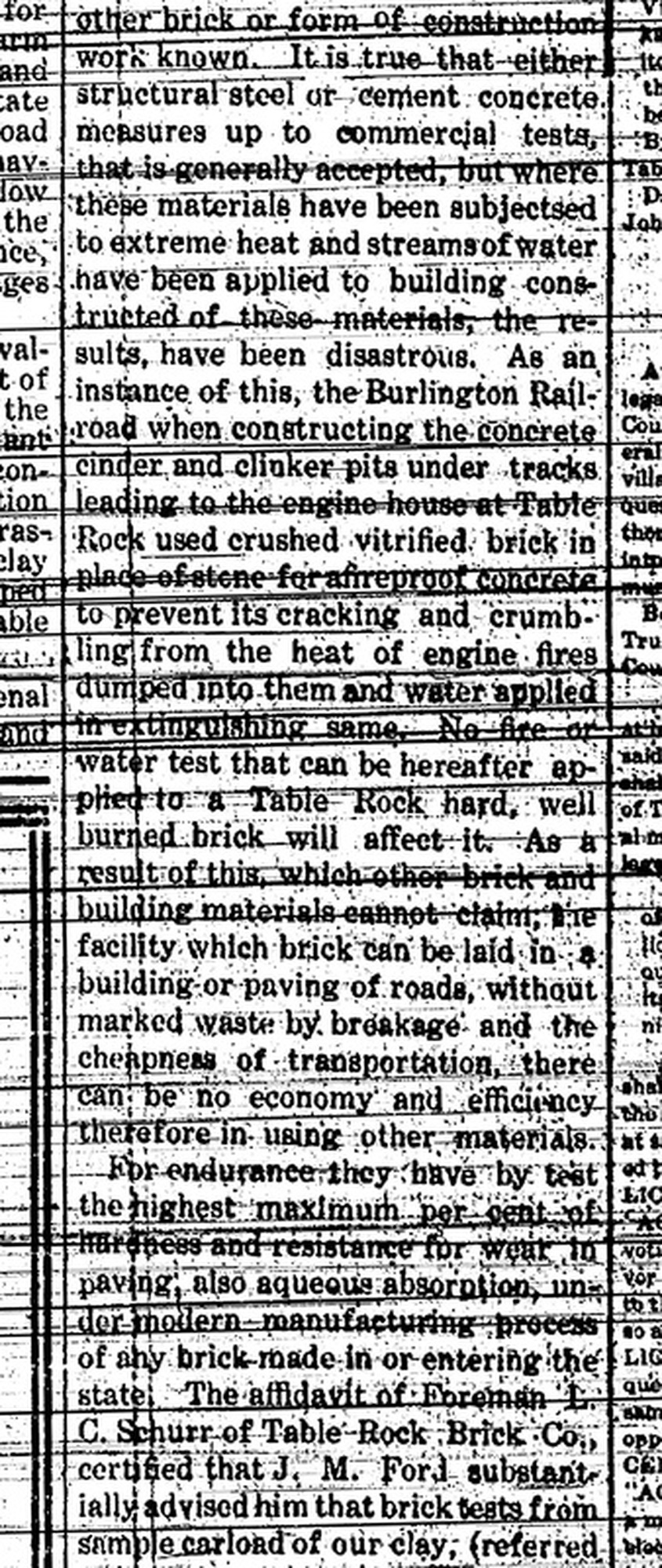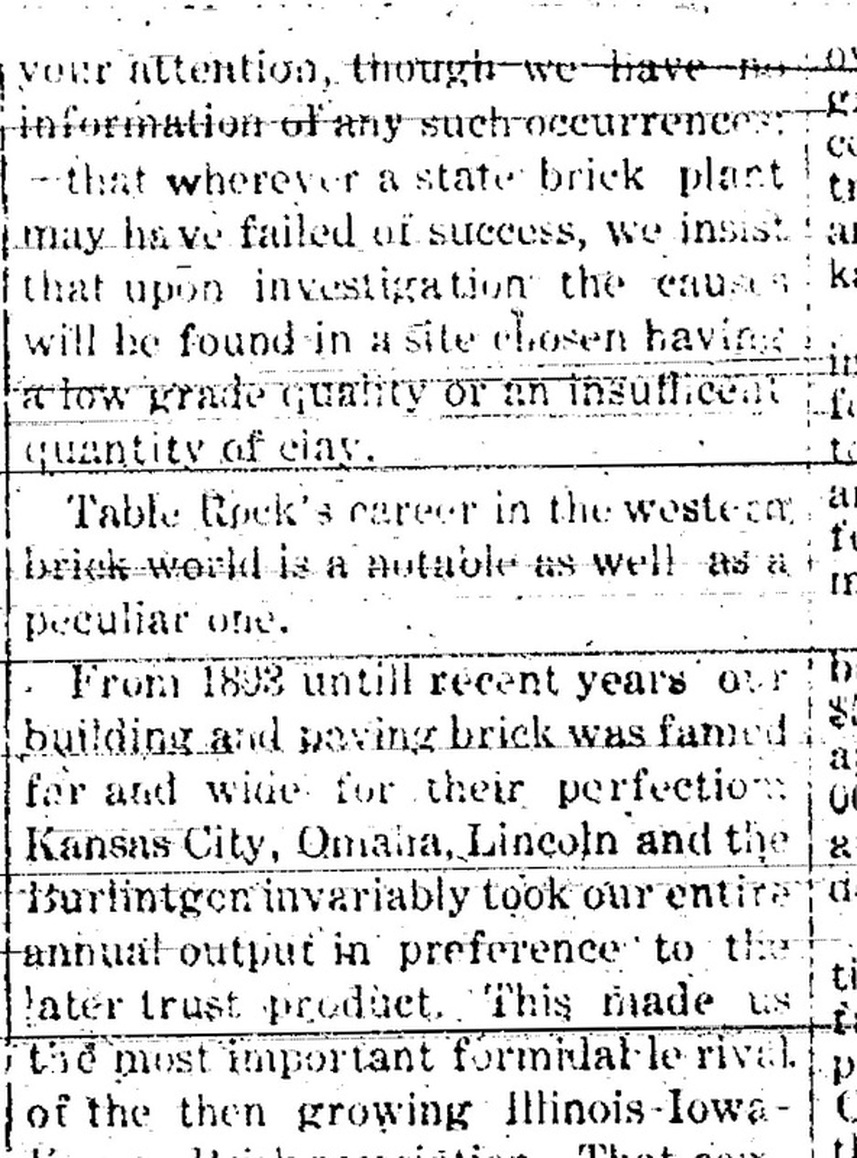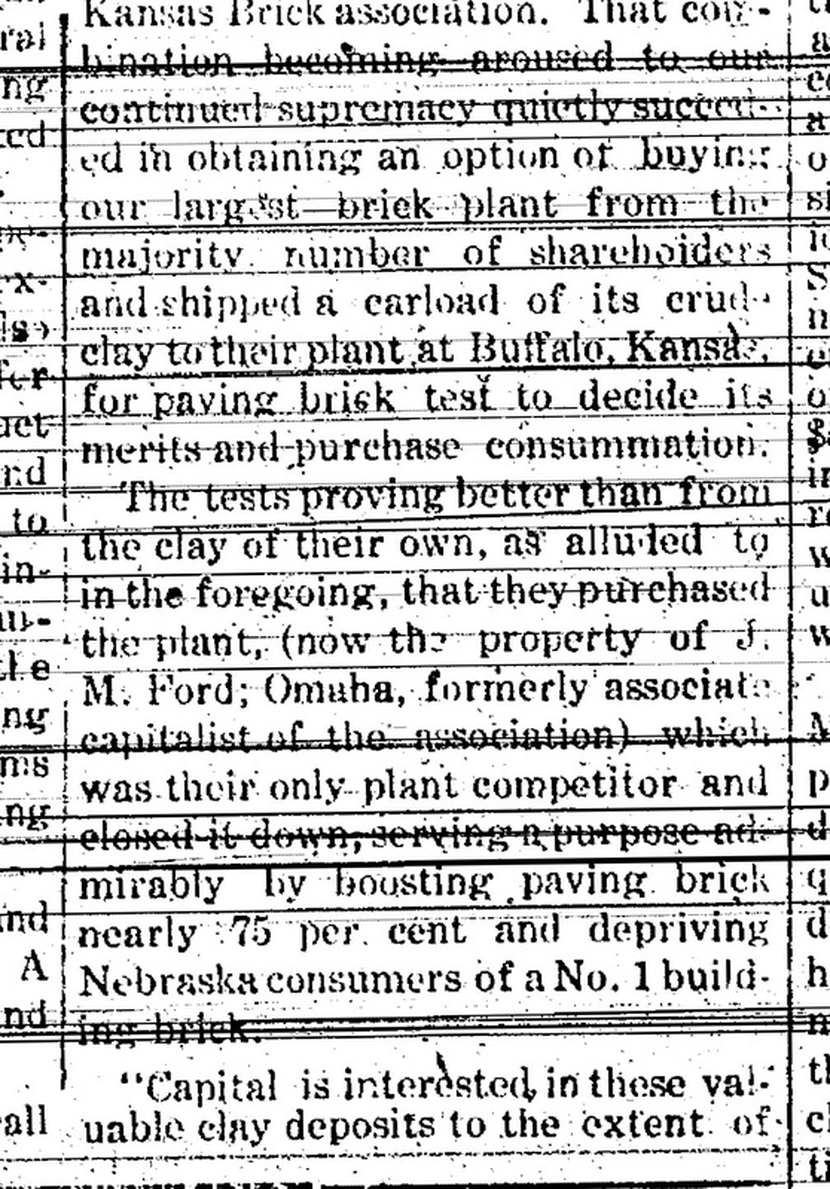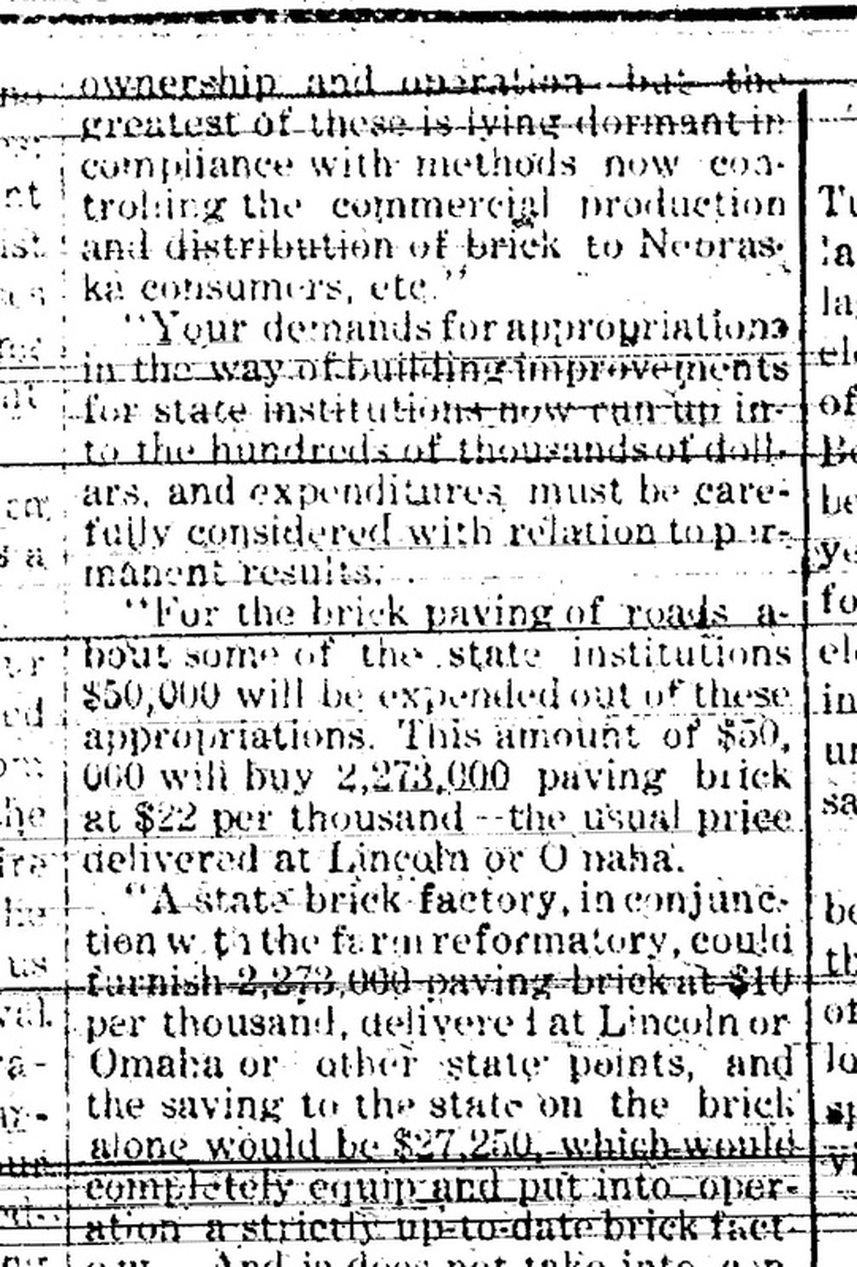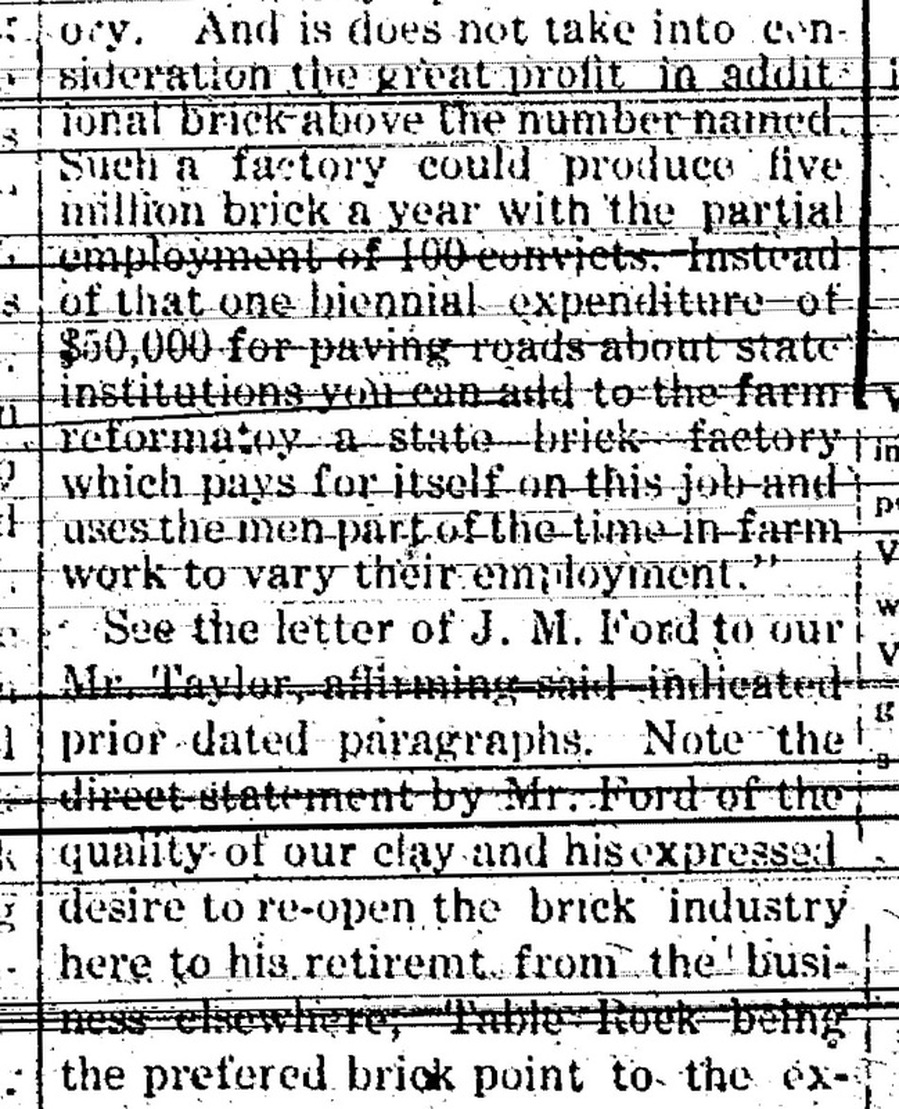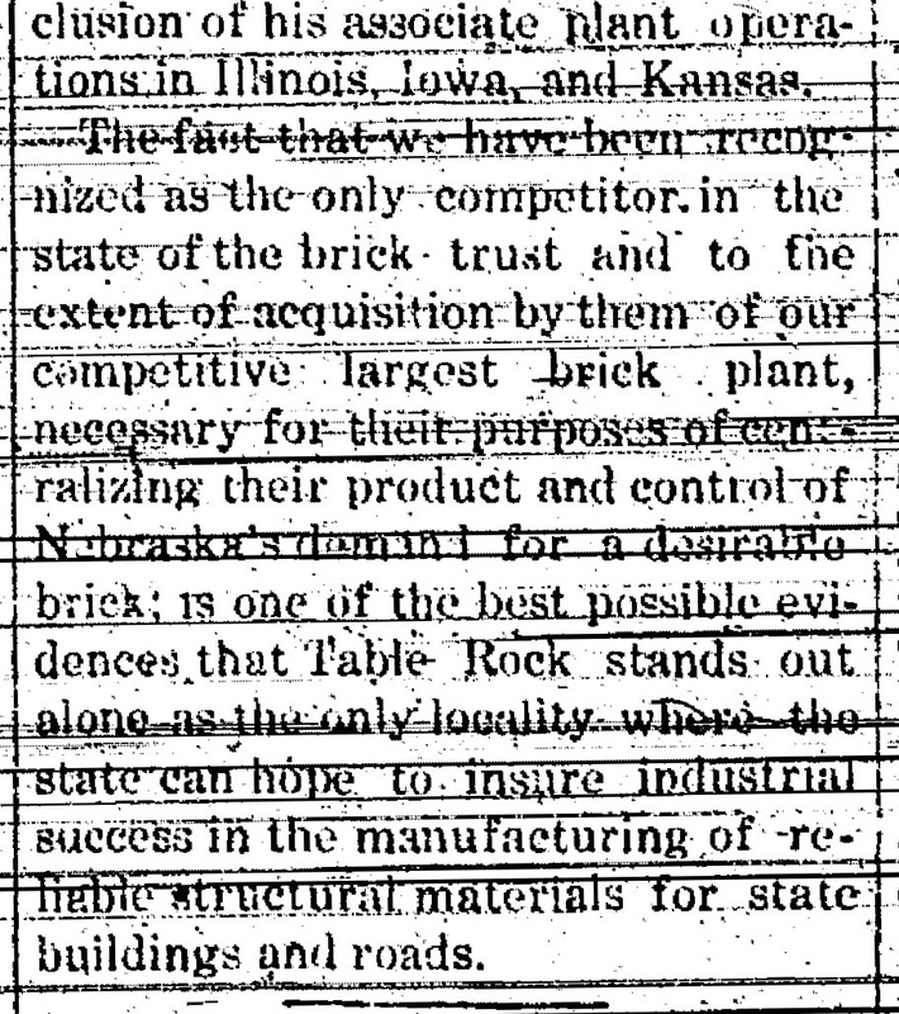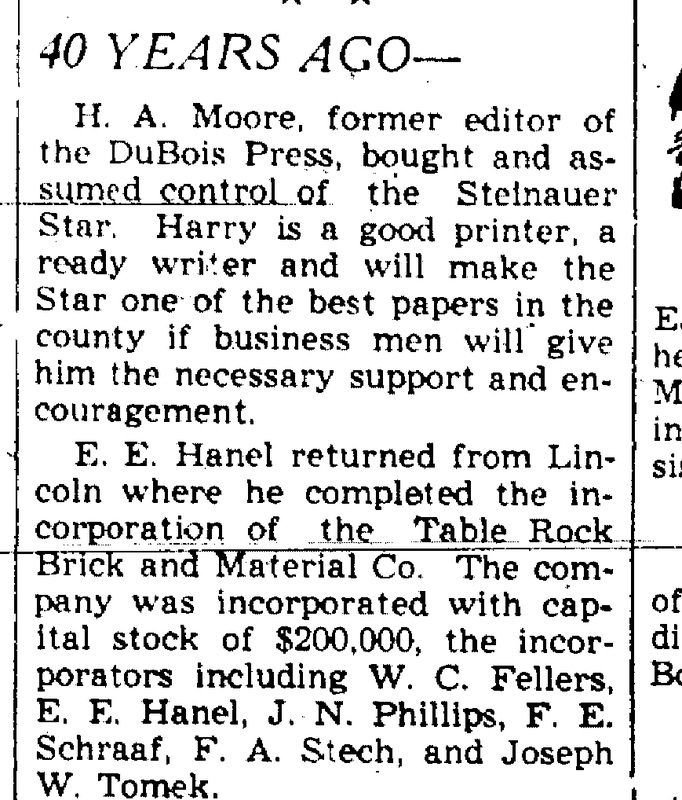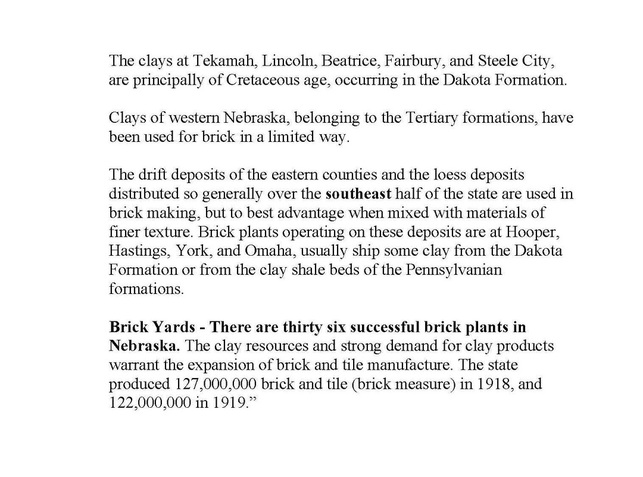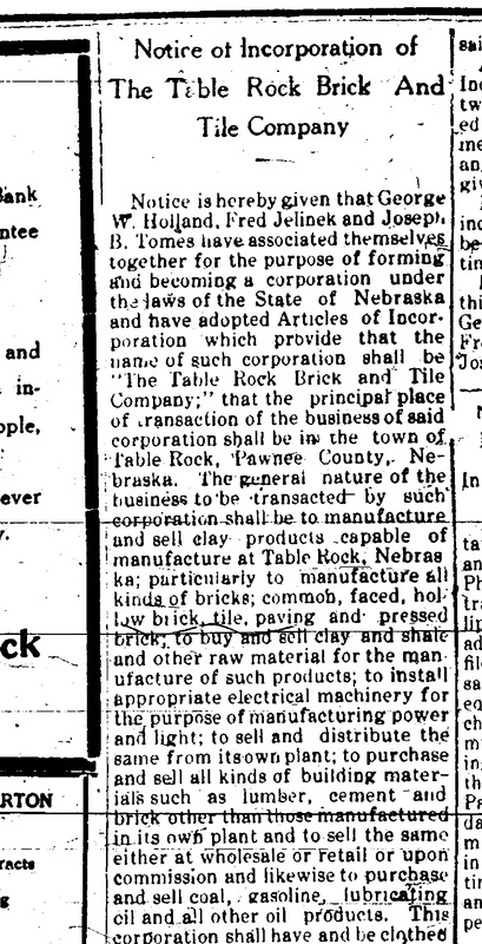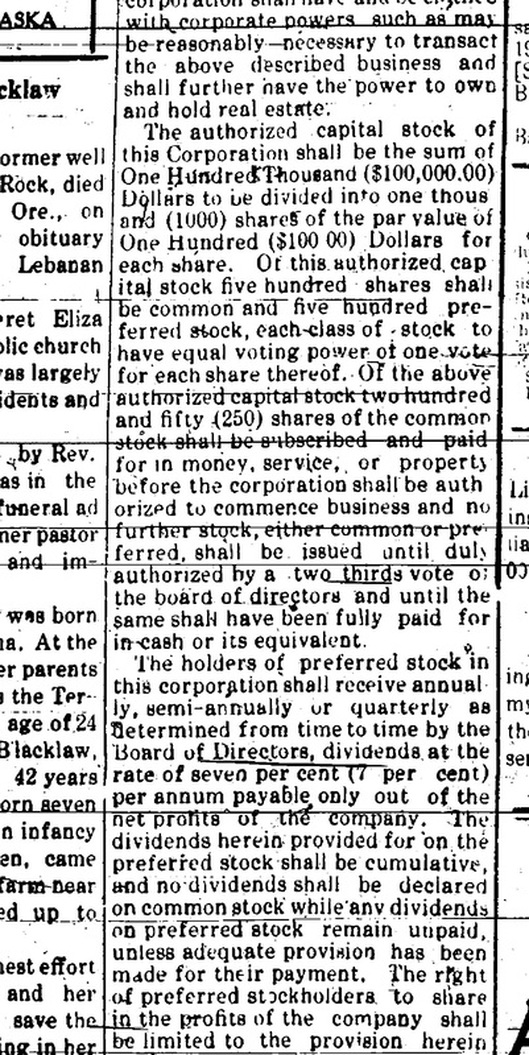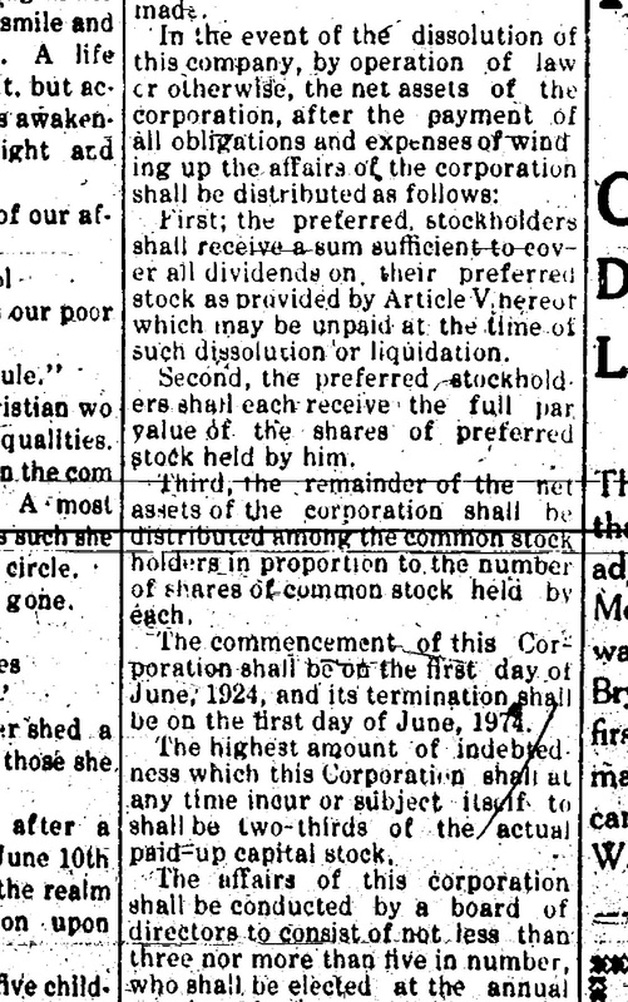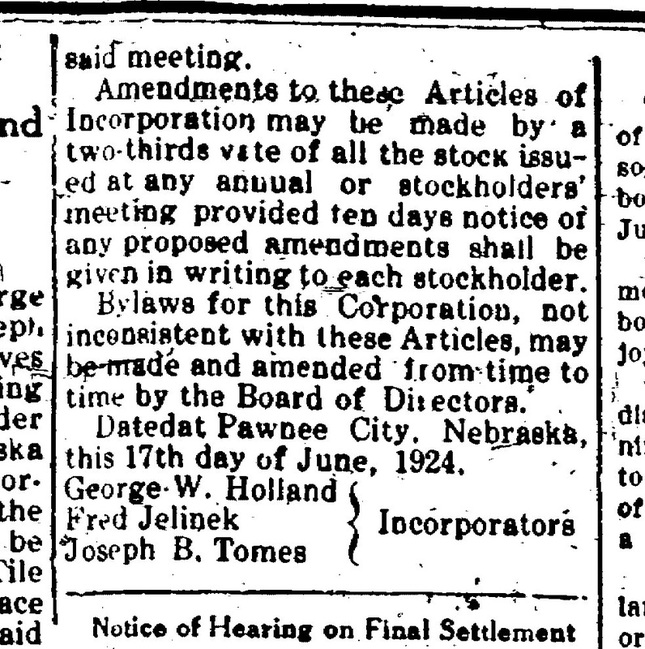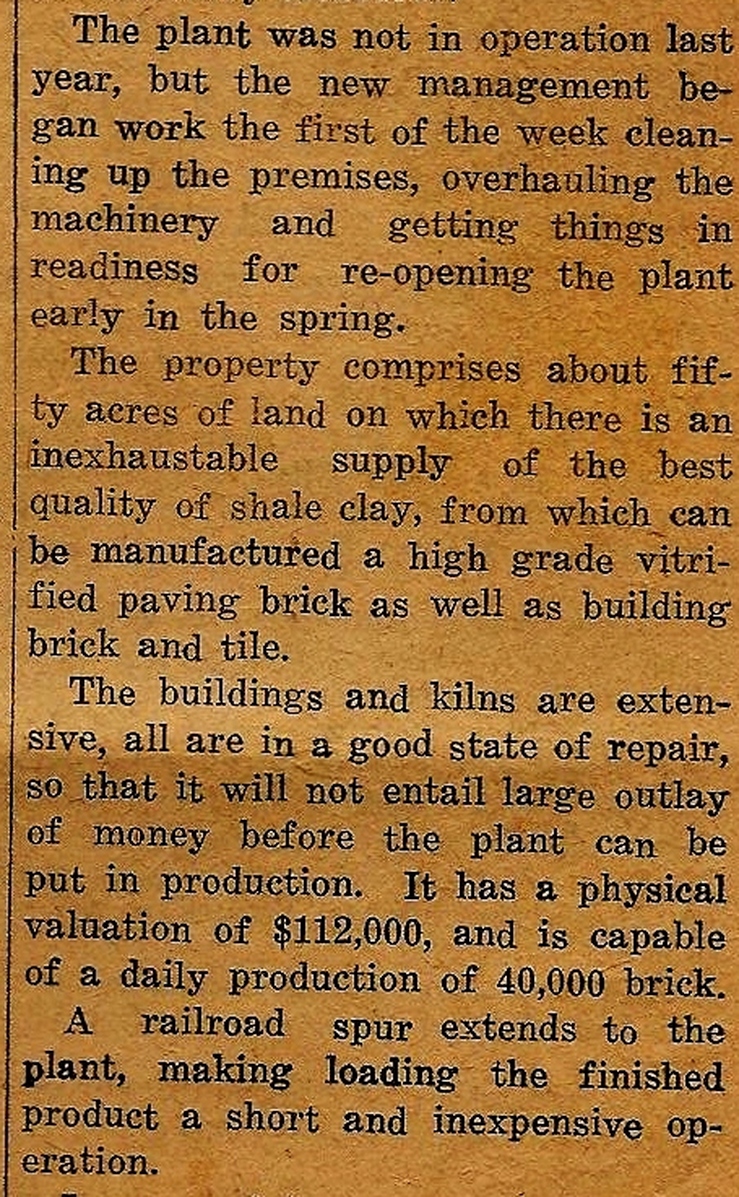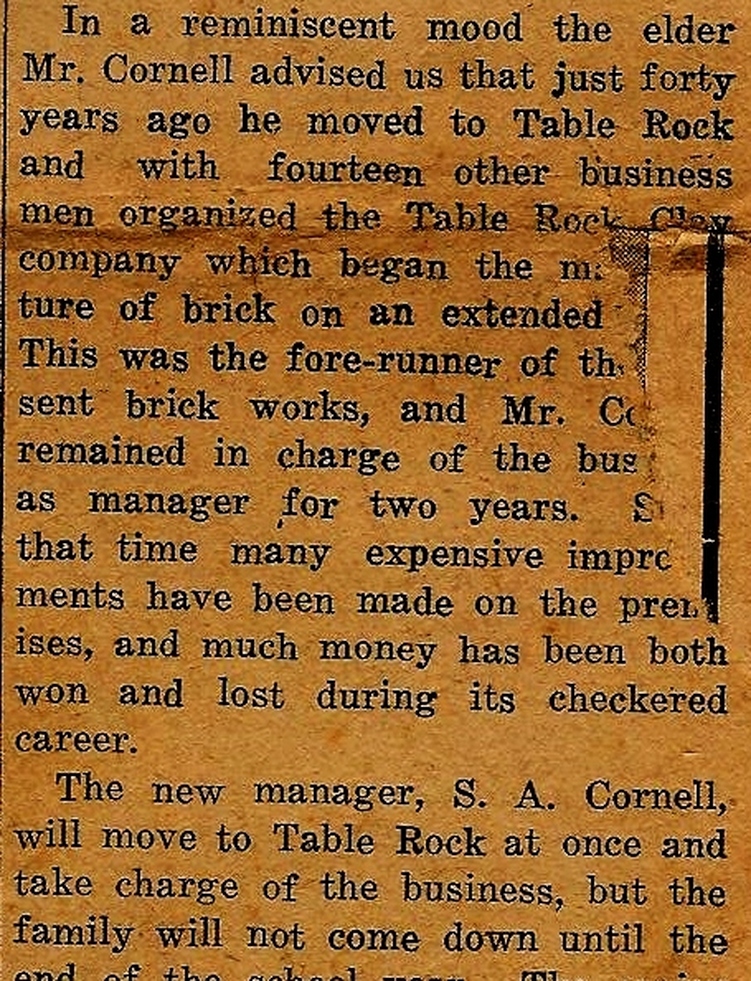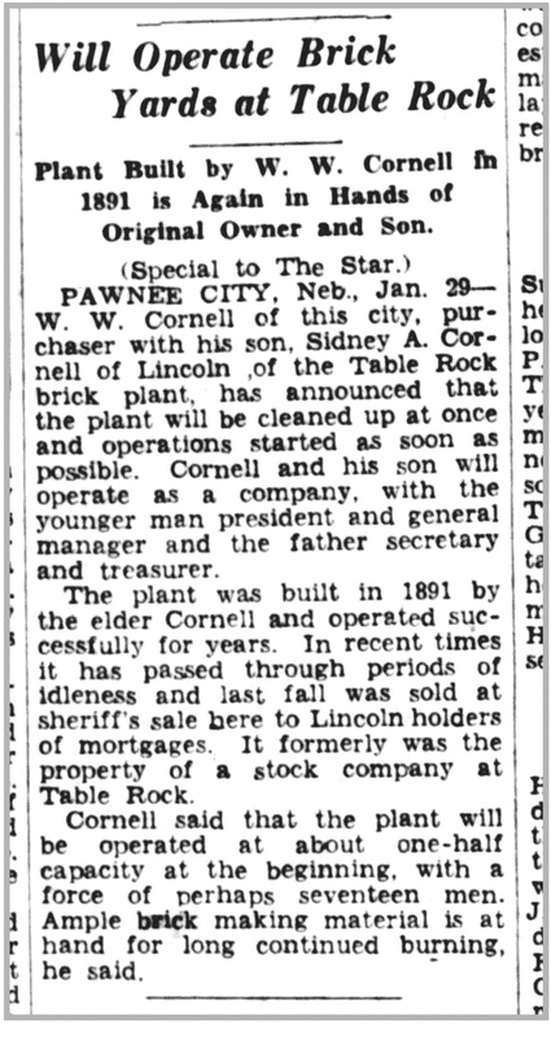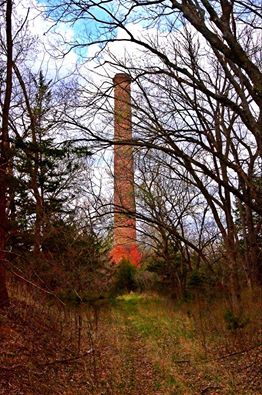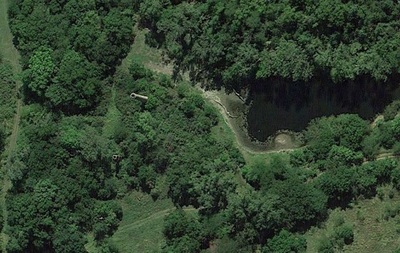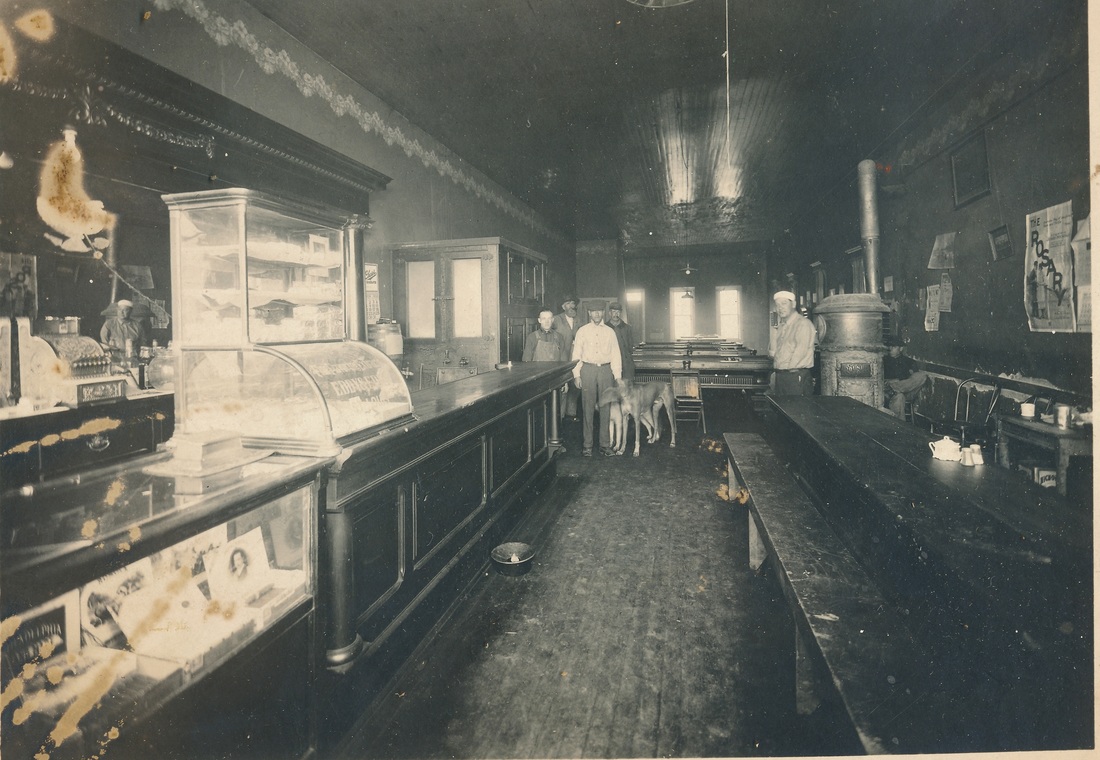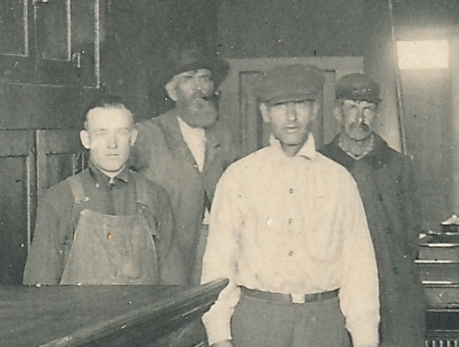clay and bricks
in table rock, nebraska
Table Rock had two brick yards, one south of town (where the high brick chimney remains) and one east of town. The south one was usually referred to as the Upper Brickyard and the eastern one as the Lower Brickyard. Records are confusing, but it seems fairly certain that Cotton was associated with the lower brickyard and William Sutton built the upper one. An 1895 state of Nebraska report notes Cotton as being associated with Table Rock Clay Company, which would place that company at the lower brickyard.
There were also clay pits that supplied other brick companies in Beatrice and Lincoln. Table Rock clay was considered superior to most.
Photographs are followed by two essays of recollections by Sutton and Tomek, then articles and other information that are arranged by year.
There were also clay pits that supplied other brick companies in Beatrice and Lincoln. Table Rock clay was considered superior to most.
Photographs are followed by two essays of recollections by Sutton and Tomek, then articles and other information that are arranged by year.
below: articles from a 2018 newsletter
photographs
recollections by sutton & tomek
articles & information year by year from 1890
bricks, bricks, bricks
newsletter #2 of 2018 offered a discussion based on then-current information
photographs
Photo 162 was labeled when posted as "scene where the first clay was taken out of the Norris Pasture by Table Rock." Discussion on the Historical society's 2015 Facebook page about the actual location considered Joe's Lake (which reportedly is the remainder of a clay pit, the question being whether it was this particular operation), the bluff adjacent to the upper brickyard, and other places. A search of records at the Pawnee County courthouse shows that the Norris family had more than one pasture, making the reference rather broad.
Excerpts of this wonderful photograph:
sutton's recollection of the brickyard, from a 1934 newspaper clipping
|
This essay appeared in the August 31, 1934 edition of the Argus. The microfilm edition of that paper is extremely difficult to read; it is below this typed transcript.
It is styled as an account by "Sutton." The brickyard was started by William Sutton and in the context provided by some of the wording in the article it seems to be an account by William Sutton himself, just published posthumously. John Sutton is cited as having helped shut down the brick yard. John Sutton died in 1951. Sutton also refers to Cotton, who had the Lower Brickyard. There are many articles and other pieces of information in the second half of this web page. |
|
The original article, very difficult to read:
a history of
the table rock clay company written by joe tomek in 1966
This article refers to the Table Rock Clay Company and renamed the Table Rock Brick and Material Company, mentioning no other incarnations of the brick companies. It places the closing of "the" brickyard as 1927; a scan of the front page of each of the 1927 editions of the Argus did not catch a reference to the brickyard closing in that year.
how bricks were made
historical records
1890
|
William Sutton, owner of a successful creamery south of town, together with G. R. (Rice) Martin, soon after to build the opera house, entered into a venture to assess a deposit of coal for mining. The vein dissipated, and the two men lost a "fortune," according to Sutton's recollections. A deposit of clay was found, but a potter said that it was useless. Nevertheless, Sutton was able to build a small brick factory to use the clay. He located it by his creamery. This is the brick factory south of town. (There was also a brickyard east of town, known also as Cotton's brickyard.)
An extensive biography of William Sutton, who died in 1930, was published in a 1932 edition of the Lincoln Star. The following portions referred to Sutton's involvement with brick manufacturing. It provides a nice overview of the subject. This article does not state the date that Sutton built his factory, but based on two other articles below, it appears that it was about 1890. |
More 1890
The Nebraska Gazetteer for 1890-1891 listed businesses in Table Rock. It says that brick and clay found in Table Rock supplies local manufacturers (plural) and also out-of-town outfits in Beatrice (Beatrice Brick & Tile Co.) and Lincoln (Lincoln Vitrified Paving and Pressed Brick Co.). Although at the outset it refers to local manufacturers in the plural, the only Table Rock brick manufacturer, it identifies Table Rock Clay Company, with G. R. Martin (who in 1893 was to built the opera house) as president and manager, William White as secretary, and William Sutton as treasurer.
1893
An accident at the brickyard, June 7, 1893, from the Columbus (Nebraska) Journal, found on newspapers.com
Another accident reportedly occurred later, but the date is uncertain, involving Katherina (Katerina) Chauza, a Czech immigrant. What she did at the factory is unknown. According to Chauza family history reported on the Historical Society Facebook group page by Luella Hinrichsen (as recalled by the website editor with partial supporting notes), Katerina fell in into a slippery clay mix and caught pneumonia. The family sold their Table Rock farm and moved to Dubois in 1900 and Katerina died not long after. Here is Photo 422 of the Chauza family, with James Chauza, Sr. (a carpenter with the railroad), and wife Katerina seated and children James, Jr., Fanny, and Anna.
1895-1896
George Cotton was associated with Table Rock Clay Company. Cotton, according to Sutton's Recollections of the Brickyards (later on this web page), had the lower brickyard. This is from the biennual report of the Nebraska Bureau of Labor and Industrial Statistics.
1899-1900
The biennual report of the Nebraska Bureau of Labor and Industrial Statistics reported two brick companies in Table Rock, Table Rock Clay Company and the Table Rock Vitrified Paving Company.
An interchange between the B&M railroad and the Table Rock Clay Company was underway. The rail line running from Table Rock to Denver, Colorado was a line of the Republican Valley Division of the Burlington & Missouri Railroad. This reference to an interchange with the B&M thus appears to refer to the upper brickyard. Earlier articles appear to reflect the brickyards as separate companies, with the lower brickyard being Table Rock Clay. A later article in 1910 refers to Table Rock Clay as having an upper and a lower brickyard, Were the brickyards consolidated under Table Rock Clay as early as 1900? If so, then where was Table Rock Vitrified Paving Company? It's confusing.
May 11, 1900 -- Buckstaff clay taken from Table Rock to a Lincoln brick factory. Bricks made of Table Rock clay have been in the street ten years (putting its manufacturing date to 1890) and are still in almost perfect condition.
"Buckstaff" clay" probably refers to J. A. Buckstaff, who started the Lincoln Vitrified Paving and Pressed Brick Company in 1888, according to an April 19,1890 article in Scientific American.
1901
November 24, 1901. With the Table Rock Clay Company has shipped nearly 6 million bricks and "the vitrified plan run by Messrs. Cotton and Allen" about the same. Table Rock has an "immense" payroll when considering those two brickyards and the gumbo fields operated by the railroad. It is uncertain whether the article intends to refer to Table Rock Clay Company as run by Cotton as separate from the "vitrified plant" run by Allen, or the vitrified plant as being run by Cotton and Allen.
1904
|
In 1904, the upper and lower brickyards consolidated, according to an industry publication, the Brick and Clay Record. That article says:
“TABLE ROCK BRICKYARDS CONSOLIDATE The brick yards at Table Rock, Neb., have practicallly closed down for the season, after the most prosperous year of their history. The two yards aggregate nearly 10,000,000 bricks. Many orders have been turned down, owing to the inability of the yards to fill them. A deal has lately been consummated by which the two yards have been consolidated, the Table Rock Clay Company taking the plant of the Cotton Company and issuing stock to the owners in payment thereof.” |
|
In other news in 1904, a patent was issued to William Sutton, who had been associated with the the upper brickyard as early as 1890-1891, had at least one patent. In this patent, there are first three pages of diagrams, followed by three pages of text description. Perhaps this patented kiln is the circular building that appears in Photo 254, the picture of the upper brickyard, which is incorporated in full above.
|
1909
|
In an obscure book from 1911 listing obsolete securities, the Table Rock brick factories are included. It says as to Table Rock Clay and Table Rock Vitrified, “charter canceled" in 1909. The brickyards appear to have died and arisen from ashes multiple times over the years.
|
1910
The prospects of Table Rock Clay Company are good. The Clay Worker, February 1910. The company had . both the upper and lower brickyards by that time
1911-1912
|
“Thirteenth Biennel Report of the Bureau of Labor and Industrial Statistics for the State of Nebraska, 1911-1912” Lincoln , Nebraska 1912.
Page 152: Table Rock Brick & Clay Company listed in list of “Artificial Brick, Stone, and Tile Institutions in Nebraska” |
1912
|
The Clay Worker, Volumes 57-58, 1912, T.A. Randall & Co., publishers, Indianapolis, IN. This appears to have been a trade publication; it says that it was published monthly, but the google book contains a consolidation of the months; volume 57 is noted as being January to June of 1912, and volume 28 July to December.
From Editorial Notes and Clippings of July 1912 edition At page 73: “W. H. McGuire was caught in a cave-in at the Table Rock (Neb.) Brick Company’s plant and buried up to his head. Although no bones were broken, he was badly bruised and was incapacitated for work for several days.” |
1913
March 26, 1913. The discussion was about how to keep the upper brick yard open for the season:
1914
Do you want a comprehensive history of the brickyards? Then take the time to read the extensive proposal of the table rock commercial club that the state prison system buy into the and brickyards. it includes a history of the brickyards and a happy description of the benefits of the table rock area. IT STRETCHES OUT OVER THREE LONG INSTALLMENTS IN THE MARCH 2014 ARGUS EDITIONS OF MARCH 13, 20, AND 27.
The Commercial Club (later the Community Club) stumped for a prison to be located in Table Rock. Their proposal was published in the March 13, 1914 Argus. The angle was that the state could make money having convicts making bricks; as many as 100 convicts could be employed by the two brick factors. The information provided about the two brickyards and the Table Rock of the day is fascinating. This is a lot of reading, but well worth it.
INSTALLMENT 1 OF 3 - MARCH 13, 1914
Elsewhere in the paper, an editorial comment made note of the proposal and encouraged citizens to support it:
iNSTALLMENT 2 - MARCH 20, 1914
INSTALLMENT 3 (THE LAST) - MARCH 27, 1914
1917
It appears that at some time after that the lower plant was bought out by the owners of the upper plant and then, some years prior to 1917, both plants closed.
In any event, in 1917, the upper plant, after having been closed for “many years,” reopened as the Table Rock Brick and Material Company. In 1923 it became the Table Rock Brick and Tile Company.
The reopening of the plant in 1917 is documented by a trade publication from that year, which reports the reopning events occurred with considerable ceremony. “In the afternoon between twelve hundred fifteen hundred school children visited the plant and a reception was given by the Commercial Club of Table Rock to the ofiicers of the company and general public. When the wheels began to turn at five o’clock, the superintendent gave a talk to the school children, explaining to them the machinery and the methods employed in brickmaking. In the evening a banquet was served at which there were one hundred and forty people present. The present capacity of the plant is 35,000 brick a day.”
The trade publication article:
April 25, 1957 - a look back to 40 years ago referred to the 1917 reopening of the upper brickyard:
1919
One of Table Rock's floods - this time of Taylor Creek -- created havoc:
1920
|
The Clay Worker
An ad from March 1920, edition, page 586 of the Google Book. “Classified Advertisements” “For sale – 7 foot American dry pan, 7 foot pug mill, 2 mold Bonnott repress, Bensing Automatic Hollow Tile Cutter. This machinery is in good working order all ready to set up and run. Can ship immediately. For full particulars write the Table Rock Brick & Material Co., Table Rock, Nebraska.” |
|
Brick Yard machinery for sale, April 6, 1920 – page 790 of volume 56 of “Brick and Clay Record”
|
But also brickyard machinery WANTED by the Table Rock & Material Company: an exhaust fan and a dragline exacavator with a double drum engine.
1921
|
An article on brick manufacturing in Nebraska gives a brief overview of the clay deposits in southeast Nebraska, including those near Table Rock, which it says are intermixed with limestone and are of the Pennsylvanian and Permian ages.
|
1924
July 18, 1924 - Notice of incorporation of the Table Rock Brick & Tile Company by George W. Holland, Fred Jelinek, and Joseph B. Tomek:
1931
From the January 28, 1931 Pawnee Chief comes this article about W. W. Cornell of Pawnee City buying "the" brickyard.
In this January 29, 1931 article in the Lincoln Star, the purchase by Cornell is again reported. It says that Cornell built the plant in 1891. William Sutton built the upper brickyard in about 1890. Perhaps, then, it was W. W. Cornell who built the lower brickyard, which was later operated by Cotton. It seems that the two brickyards eventually merged under one ownership. In any event, no brickyard may ever have been reopened, although a 1974 newspaper article noted that the brickyard ceased operating "in the early 1930s." The date was probably the late 1920s.
1974
It is unknown when the lower brickyard ceased to operate or when it was dismantled. The bricks of the upper brickyard were salvaged in 1974. This article says that the company closed up in "the early 1930s," which may or may not be accurate.
2015
From Edward Tomek, as told to Sharla Cerra in 2015:
The upper brickyard was owned by Joe W Tomek when it closed. I believe the lower town brick yard was farther east than most are talking about. It was on the Art Vrtiska place, still owned by Ivan Vrtiska. That place is about half mile SE of the present Reno Inn. When I was a kid, there was a lake there that I used to fish in. The lake was a result of digging done by the brickyard. There also were remnants of the old brick yard then. Not sure if the lake or remnants remain.
The upper brickyard was owned by Joe W Tomek when it closed. I believe the lower town brick yard was farther east than most are talking about. It was on the Art Vrtiska place, still owned by Ivan Vrtiska. That place is about half mile SE of the present Reno Inn. When I was a kid, there was a lake there that I used to fish in. The lake was a result of digging done by the brickyard. There also were remnants of the old brick yard then. Not sure if the lake or remnants remain.
Recent photos. Smoke stack at Upper Brickyard by Kim Vrtiska. The other view is from Google Earth, thanks to Stan Sitzman.
Photo 422. Jas Chauza, Sr., & lKaterina Bily Chauza with Fanny, Jas Jr, and Anna. James was a Czech settler who worked on the railroad and as a carpenter. Katerina worked at the brick factory. They bought a farm in Table Rock. In 1900, they sold the farm and moved to Dubois. A descendant says that the family history is that Katerina died not long after; it was believed that it was as a result of falling in a clay receptable at the brickyard, of uncertain etiology.
January 28, 1951. John Sutton (born in 1871) a longtime former resident who was connected with the brickyard. William Sutton ran the brickyard and creamery. William Sutton's oldest child was John N. Sutton, probably this John Sutton. William Sutton was born in 1844, John Sutton in 1871.
lewis day worked at the brickyard |
Lewis Day, 84 year old, born 1900, had many jobs, including working at "the" Table Rock brick yard:
LEWIS DAY, 84 YEAR RESIDENT
Lewis Day, who is 84 years young spends much leisure time on his front porch watching the rest of the world go by reflecting on many things.
Among his recent contemplations was the possibility that he may have lived in the village of Table Rock longer than anyone presently living here.
Lewis was born on Sept. 6, 1900 to Silas and Mary Day and has lived in this area all of his 84 years, having moved to the Village of Table Rock in 1916.
Throughout his life he has never found a lack of work. He has had many jobs including, farm hand, working in the former Table Rock Brick Yard, employed with the Burlington Railroad in Table Rock and been employed over ten years by the local Table Rock Farmers Co-Op.
In 1963 he was forced to retire due to problems with his eyes.
Even in retirement Lewis managed to find something he could work at.
He says he thinks he has mowed yards for most of all the widow ladies in Table Rock. He had to give that up in 1980 due to arthrites which affected his knees.
During his life time Lewis was Mayor of Table Rock, an active fireman and Odd Fellow Lodge member.
Presently he takes life comparatively easy but still maintains a very productive garden, keeps his house in ship-shape condition and does his own cooking. His leisure time he occupies by watching TV, playing cards, enjoying having family members visit him often on weekends. Even at 84 Lewis finds life interesting and worthwhile. (Pictured is Lewis Day in his favorite chair on the front porch of his home where he spends many hours of his leisure time)
LEWIS DAY, 84 YEAR RESIDENT
Lewis Day, who is 84 years young spends much leisure time on his front porch watching the rest of the world go by reflecting on many things.
Among his recent contemplations was the possibility that he may have lived in the village of Table Rock longer than anyone presently living here.
Lewis was born on Sept. 6, 1900 to Silas and Mary Day and has lived in this area all of his 84 years, having moved to the Village of Table Rock in 1916.
Throughout his life he has never found a lack of work. He has had many jobs including, farm hand, working in the former Table Rock Brick Yard, employed with the Burlington Railroad in Table Rock and been employed over ten years by the local Table Rock Farmers Co-Op.
In 1963 he was forced to retire due to problems with his eyes.
Even in retirement Lewis managed to find something he could work at.
He says he thinks he has mowed yards for most of all the widow ladies in Table Rock. He had to give that up in 1980 due to arthrites which affected his knees.
During his life time Lewis was Mayor of Table Rock, an active fireman and Odd Fellow Lodge member.
Presently he takes life comparatively easy but still maintains a very productive garden, keeps his house in ship-shape condition and does his own cooking. His leisure time he occupies by watching TV, playing cards, enjoying having family members visit him often on weekends. Even at 84 Lewis finds life interesting and worthwhile. (Pictured is Lewis Day in his favorite chair on the front porch of his home where he spends many hours of his leisure time)





